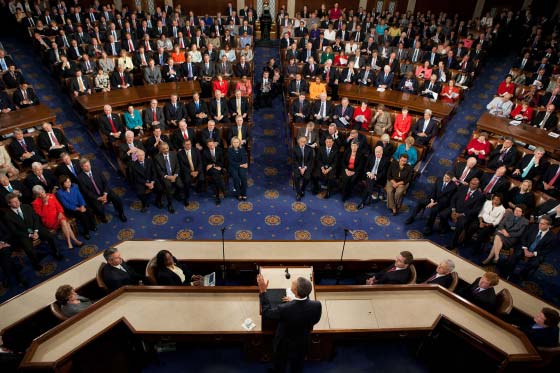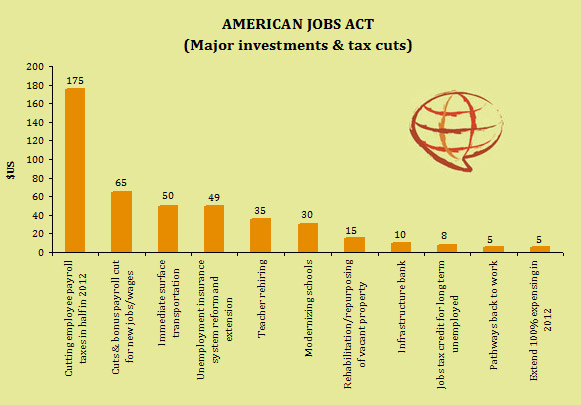
US$ 447 bn to create employment
Some 9.1% of Americans are currently out of work (nearly 43% of them have now been out of work for more than six months), an issue that is expected to dominate the election campaign. For this reason last September 8th President Obama unveiled the American Jobs Act, his latest stimulus plan, this time majorly intended to create jobs but also to spur the economy. Nearly all of the plan is made up of ideas that have been supported by both Democrats and Republicans. Now the plan (which at the moment it is just a President’s proposal) needs to be passed by the Congress (expected to be done yesterday, we will keep you up-to-date).
The purpose of the American Jobs Act is according the White House: “to put more people back to work and put more money in the pockets of working Americans – without adding a dime to the deficit.” The proposal includes more than $248 billion in tax incentives for small businesses and employers, according to administration estimates. The rest of the money would be devoted to infrastructure spending, state aid, unemployment insurance, and neighborhood rehabilitation. Overall, the bill would deliver roughly $450 billion in job creation measures, a majority of which would come in the form of tax breaks. Because the bill is mostly focused on 2012, it is similar in scale to the 2009 recovery act.
President Barack Obama’s jobs package could lift economic growth by one to three percentage points in 2012, add well over one million jobs and lower the unemployment rate by at least half a percentage point, judging by early estimates.
The plan: main contents
The American Jobs Act has five key components:
1. Tax Cuts to Help America’s Small Businesses Hire and Grow: new tax cuts to businesses that provide immediate incentives for firms to hire and invest. These tax cuts would be available to all businesses, regardless of size, but are designed to target their impact towards the smallest businesses.
Measures:
– A payroll tax cut to businesses, with a focus on small employers.
– A complete payroll tax holiday for new jobs or wage increases.
– Extend 100 percent business expensing through 2012 ($5 billion).
– Help entrepreneurs and small businesses access capital and grow.
- Changing the Way the Government Does Business with Small Firms.
- Reducing Regulatory Burdens on Small Business Capital Formation.
- Helping Small Businesses Compete for Infrastructure Projects.
- Passing Patent Reform.
2. Putting Workers Back on the Job While Rebuilding and Modernizing America: the purpose is to put Americans back to work in key areas that are central to America‘s future competitiveness. Repairing and modernizing classrooms across the country and making sure that teachers who have been laid off because of budget cuts can be brought back to work. It will take on the fact that the American Society of Civil Engineers (ASCE) awarded the United States a ‘D’ for the overall condition of its infrastructure. Both to modernize the nation‘s roads, railways, airports and schools and to put hundreds of thousands of workers back on the job.
Measures:
– A Helping Hand for Veterans.
– Preventing Teacher Layoffs and Keeping Police Officers and Firefighters on the Job ($35 billion).
– Modernizing At Least 35,000 Public Schools – From Science Labs and Internet-Ready Classrooms to Renovated Facilities ($30 billion).
- Safer, Healthier, and Technologically-Advanced Schools of the Future.
- A Focus on Schools in Need.
- Modernizing Community Colleges to Train a 21st Century Workforce.
– Immediate Investments in Infrastructure ($50 billion).
- Investments in Making US’ Highway Systems Safer and More Efficient.
- Repairing Transit Systems and Improving Rail Systems.
- Improving Airports.
- Opportunities in the Transportation Sector.
- Funding for Innovative Transportation.
- Expediting High Impact Infrastructure Projects.
– National Infrastructure Bank ($10 billion)
- Independent, Non-Partisan Operations Led by Infrastructure and Financial Experts.
- Broad eligibility for Infrastructure and Unbiased Project Selection.
- Addressing Market Gaps for Infrastructure Financing.
– Project Rebuild: Putting People Back to Work Rehabilitating Homes, Businesses and Communities ($15 billion).
- Focus on Distressed Commercial Properties and Redevelopment to Stabilize Communities.
- Include For-Profit Entities to Gain Expertise, Leverage Federal Dollars and Speed Program Implementation.
- Increase Support for “Land Banking”.
- Create Jobs Maintaining Properties and Avoiding Community Blight.
– Expanding Nationwide Wireless Internet Services For the Public and the First Responders, in a Fiscally Responsible Way.
3. Pathways Back to Work for Americans Looking for Jobs: extension of unemployment insurance to prevent 6 million Americans looking for work from losing their benefits, while at the same time reforming the system to help support programs that build real skills, connect to real jobs, and help the long-term unemployed.
Measures:
– Reform Unemployment Insurance System to Provide Greater Flexibility, While Ensuring 6 Million People Do Not Lose Benefits ($49 billion).
- Rigorous Reemployment Assistance.
- Work Sharing: UI reform to prevent layoffs.
- State Flexibility for Bold Reforms to Put the Long-Term Unemployed Back To Work.
– Tax credits for businesses that hire the long-term unemployed ($8 billion).
- An Effective, Targeted Measure.
- Rising to the Challenge of Persistent Unemployment.
– Investing in Low-Income Youth and Adults ($5 billion).
- Support for Summer and Year-Round Jobs for Youth.
- Subsidized Employment Opportunities for Low-Income Individuals Who Are Unemployed.
- Support for Local Efforts to Implement Promising Work-Based Strategies and to Provide Training Opportunities.
– Ending Discrimination Against the Unemployed.
4. More Money in the Pockets of Every American Worker and Family: put more money in the pockets of working and middle-class Americans by providing tax relief to 160 million workers – extending the payroll tax cut passed last December. Congress approved a cut in the tax for workers last year, from 6.2% to 4.2%. But that measure was due to expire in December. Mr Obama wants to continue that cut next year, lower the tax even further to 3.1% for workers, and extend a similar cut to companies, at a cost of $240bn.
Measures:
– Cutting Payroll Taxes in Half for 160 Million Workers Next Year ($179 billion)
- A Targeted Tax Cut for American Workers.
- A Boost to Economic Growth and Job Creation.
- A Tax Cut That Has Received Bipartisan Support in the Past.
- Social Security Trust Fund Would Not Be Impacted by Payroll Tax Cut.
– Helping More Americans Refinance Mortgages at Today’s Historically Low Interest Rates.
5. Fully Paid for as Part of the President’s Long-Term Deficit Reduction Plan: as the White House states, “The President will release a detailed deficit reduction plan in the coming days that will pay for every penny of the American Jobs Act and include additional deficit reduction sufficient to stabilize our debt as a share of our economy.”
Pros and cons
Do you want to get some opinions on the plan? Here you are a couple of articles talking in favour of it and another couple talking against it, you choose the best part of each of them:
Pros:
Obama’s jobs speech: Good plan, good vision, good politics
The Most Overlooked (and Important) Proposal in Obama’s Jobs Plan
Cons:
Obama’s Jobs Plan: Timely, Targeted, but Incomplete
McConnell: Obama Jobs Plan Will Be ‘Same Failed Approach’
This is a nonprofit explanation
¿Quieres recibir más explicaciones como esta por email?

